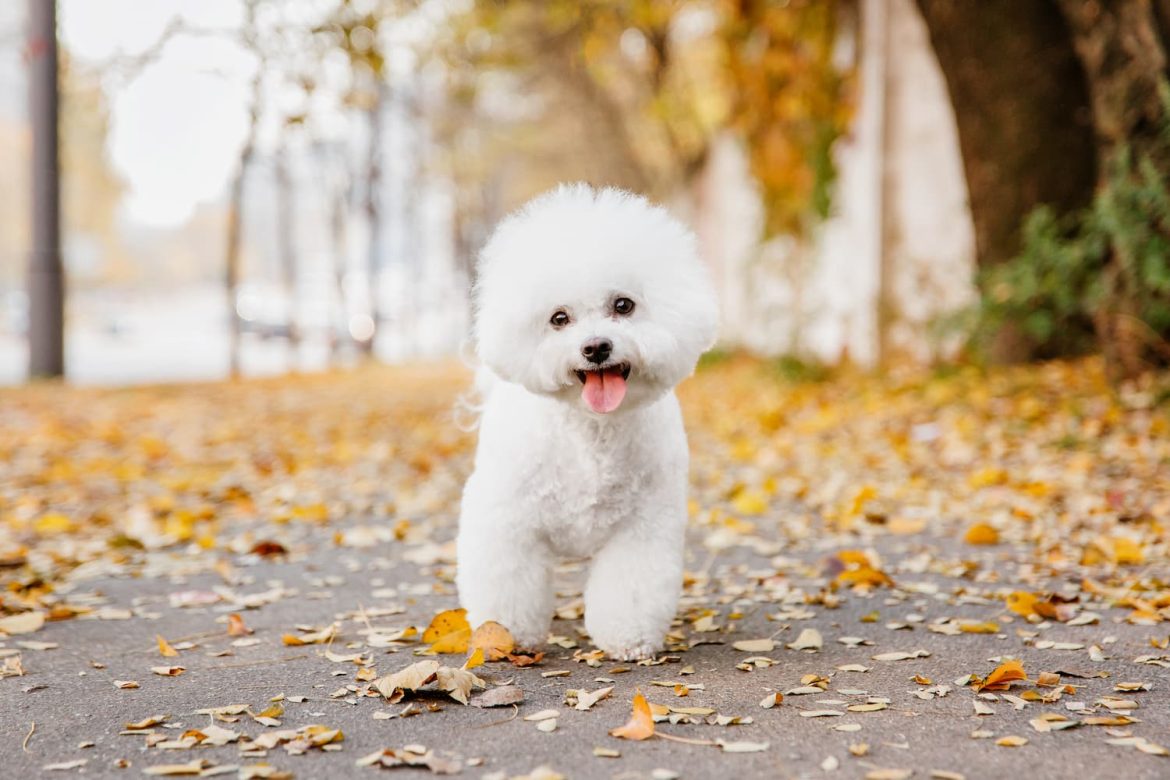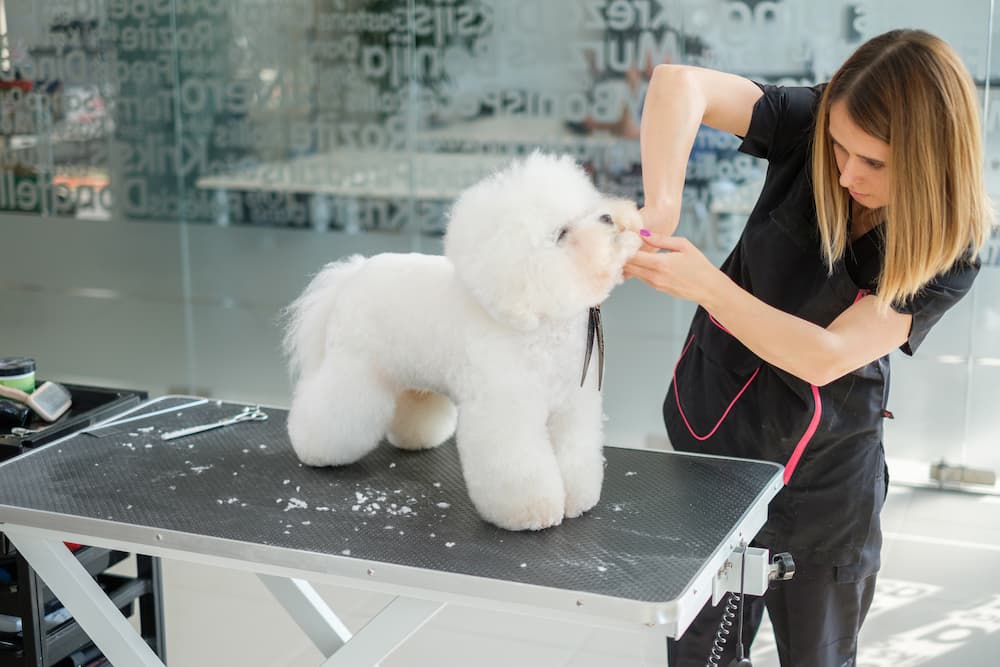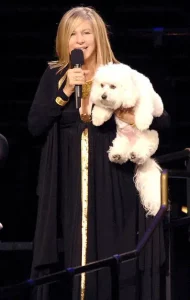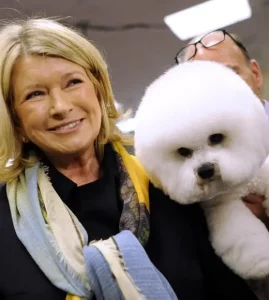Quick Facts:
- Height – 24-30cm
- Weight – 5-8kg
- Lifespan – 15 years
- Country of origin – Spain, Canary Islands
- Breed type – Non-sporting Group
- Best breed for:
– Families who spend a lot of time at home
– Apartment-living
– Households with other pets
Bichon Frise History
French? Phonecian? Italian? Spanish? There are many theories as to where this dog originally came from! No matter what, they’re true Mediterranean pups at heart, and their history has been quite the voyage!
One thing that’s certain is that the Bichon Frise is the direct descendant of a dog called the Bichon Tenerife, which got its name from the Tenerife Island of the Canary Islands. During the 13th and 14th centuries, these small white dogs were commonly traded along sea routes between Spain to Italy and even as far as Greece and Egypt. You might have seen another offshoot of these original white doggos: the Maltese.
Over time, it wasn’t just tradesmen and everyday shoppers buying and selling the small white dogs. Aristocratic dog lovers started to gain an appreciation for the breed, and their value shot up exponentially. By the 16th century, the Bichon Tenerife had become the Bichon Frise (frisé meaning curly-haired in French), a dog owned almost exclusively by French, Spanish, and Italian royalty.
These well-mannered lap dogs made excellent pets for their wealthy and powerful Owners. Throughout this time period, you can find portrait after portrait of Europe’s ruling class depicted with their Bichon Frise dogs. Henry III of France was even known to carry his around with him wherever he went.
Of course, if you’ve brushed up on your European history, you might anticipate that a storm is on the horizon for the Bichon Frise. Because, with the French Revolution, these puppers had to say goodbye to their regal lifestyle. In fact, as lap dogs so closely associated with the aristocracy, they were much less appealing than the useful hunting dogs formerly owned by the ruling class. Without a specific skill, the Bichon Frise was left to fend for themselves on the streets of Paris and beyond.
But, as anyone who’s ever spent time with a Bichon Frise knows, these dogs don’t give up without a fight. Their people-loving nature and intelligence made them appealing for street performers, who found them highly trainable, entertaining, and visible from a distance. Before long, they had wiggled, jumped, and danced their way back into the good graces of French society.
Unfortunately, it wouldn’t always be smooth sailing. The two world wars threatened to wipe out the breed completely. It was only thanks to the tireless efforts of dog fanciers in the aftermath of World War II that we can enjoy the Bichon Frise today. By 1975, they had earned official recognition in the American Kennel Club, and later in 1981, they were welcomed into the United Kennel Club, as well.
Today, the Bichon Frise is right back where they belong: in the lap of loving Owners all over the world!
Bichon Frise Personality
This dog is all about companionship, and you’ll find that they’ve got a winning personality that’s easy to fall in love with.
When it comes to their beloved family, you might assume that they’re attached by invisible strings. They always want to be near their Owners and will flash a very sweet smile to ask whether they can climb into your lap. As you might have guessed, this is a dog with a high penchant for separation anxiety. They may tolerate some time on their own in a crate or with a puzzle toy, but anything longer than a few hours at a time will likely make them very blue. It’s best to leave them in the care of a friendly Pet Sitter to satisfy their need for human connection.
Despite their velcro dog tendencies, these dogs do have a playful, curious spirit that will have them hopping off your lap in search of adventure. They love to play with other dogs of a similar size, children, and even cats. They’re typically welcoming of strangers and will do quite well on outdoor adventures to dog-friendly restaurants and the like.
There is a big caveat here, though. As ideal as the Bichon Frise personality looks on paper, it’s only possible if you’ve properly socialised your pup. Remember that all small dogs have the potential to develop a range of defensive and aggressive behaviours if they’ve developed a fear of the big world around them. In order to lower the risk of Small Dog Syndrome in the Bichon Frise, it will be important to introduce your pet to a wide variety of situations, strangers, and other animals to help boost their confidence and make positive associations.
All in all, this charming, friendly pup is a favourite with families, single adults, new Dog Owners, and just about any other kind of dog lover!
Trainability & Training Tips
Any time that you’re dealing with an intelligent pup, you have to wonder whether that will translate to trainability. The challenge with the Bichon Frise is convincing them to follow your lead rather than their own clever devices. Here are a few tricks to train this pup:
- Start with treat training. Tasty rewards are a quick and sure way to convince a Bichon Frise that they’re going to love training! If your pup isn’t super food motivated, you might try having a few different treats on hand so that you can keep their interest with more variety.
- Use plenty of praise. Another major motivation for a people-oriented dog is praise, and the Bichon Frise can’t get enough! So, whenever they do something right, smother them with verbal praise and pets.
- Always make it fun. Like most small dogs, a harsh voice or intimidating stance will likely overwhelm and scare your dog during training. Instead, think of every training session like a fun game so that your doggo is in the right mindset to learn.
- Be prepared to be ignored, sometimes. Some Dog Owners of this breed describe them as having “selective hearing,” which can be frustrating during a training session. It could be that there are too many distractions that your Bichon Frise just can’t ignore! So, try changing locations and see if you get more success. With consistency and yummy rewards, those moments of distraction will—hopefully—fade away.
- Don’t forget this dog’s performing background! Sure, they spent many years living in the lap of luxury, but remember that these dogs have picked up a few performance skills since then! Once they’ve mastered the basics like “sit,” “come,” and “leave it,” consider teaching them more complex, showy, and fun tricks. Not only will it give them mental stimulation and satisfaction, but you’ll build a better training and personal relationship with your dog.
Exercise Needs & Living Conditions
Even a pup with lapdog roots needs some exercise! And with the Bichon Frise, you should have a goal of about 30 minutes of activity per day. With just a half hour, they’ll be ready to cuddle up and relax alongside their favourite humans. Here are a few ideas for tiring out a Bichon:
- Walking. Those little legs are quicker than they look, making a Bichon Frise an excellent walking partner. With a 20 to 30 minute walk, they’ll get a great workout and enjoy mental stimulation to keep them happy.
- Freeplay with other dogs. Whether it’s the small dog park or a meetup with other Bichon Frise Owners, your pupper will love to romp around with other dogs.
- Fetch. Not all dogs in this breed will take to fetch, but for the ones that do, a 20 minute game in the backyard is a brilliant way to get moving! If your Bichon Frise isn’t excited about fetch, they may be more motivated by other interactive play like tug-of-war.
- Swimming. It might surprise people unfamiliar with the breed, but don’t forget this was a sea-faring doggo! They’re perfectly capable of learning how to swim, although they might take some coaxing to get in the water. If you’re able to convince them to dive in, they’ll benefit from a great form of exercise.
- Agility. Who can forget Winky the Bichon who wowed the crowd at the Westminster Agility Trials of 2019? Winky did not come to win the title, but she did come to win the hearts of her adoring fans. And, she got a great workout in the process.
With an engaged, smart dog like this one, daily exercise is a non-negotiable. If you’re not able to take your pooch out for a walk, make sure to call in a friendly Dog Walker. You might save yourself from some destructive habits!
In terms of living conditions, Bichons are ideal for apartment-living, and they’ll quickly endear themself to all your neighbours. That said, they can be a bit chatty, so you might need to consider a “quiet” command to manage the barking.
As they get older, you’ll want to take some special precautions to make them more comfortable, such as installing ramps or steps. But, as pups and healthy adults, they’ll have no problem jumping up on the sofa for a nice cuddle.
Bichon Frise Grooming
The Bichon Frise is often mistaken for a Poodle because of that distinctive white curly coat. And, you’ll find that their grooming needs are quite similar.
Daily brushing, with a wide-tooth comb or a pin brush, will keep their coat detangled and free of debris. You’ll want to make sure not to overlook their underside, where matting is most likely to occur.
Bichon Frise are typically bathed every two weeks or twice a month and trimmed about once a month. If that seems like a lot, you’ll understand why many Owners of this breed make sure to find a groomer early on! If you’re drawn to that quintessential poofy Bichon look, you’ll need to commit to the high-maintenance grooming lifestyle. You can stick with a more natural look that won’t require quite as much work. But either way, this doggo requires grooming commitment.
The good news is, that coat is hypoallergenic and non-to-low shedding, so your home will be mostly dog fur-free!
In addition to brushing and bathing, you’ll need to spend some time each day cleaning their face and other areas where they may develop fur staining. Nail trimming and teeth cleaning will round out the Bichon’s grooming needs.
Bichon Frise Health
While typically healthy, Bichon Frise Owners should be proactive about getting their pup on a reliable pet insurance plan. There are a few common health concerns for the breed, so it’s best to get them checked out by a vet eartly to monitor their general healthy and the following:
- Patellar luxation
- Allergies
- Vaccination Sensitivity
- Bladder problems
- Eye issues, including cataracts
Because they are often considered to be lap dogs, unhealthy weight gain is another risk factor for the Bichon Frise. Make sure that they get the right amount of exercise as well as an all-natural, balanced diet to maintain a healthy weight.
Fun Fact
Today, the Bichon Frise is a doggo for the everyday family. But, they’ve also reclaimed their status with modern day royalty! Celebrities adore the breed, with big-name Owners like Martha Stewart, Jessica Simpson, Demi Lovato, and Barbara Streisand all cuddling up with their own Bichon Frise.
Final Thoughts on the Bichon Frise
They’ve sailed on ships, lounged in the French royal court, performed in the streets of Paris, and faced the paparazzi alongside their celebrity Owners. And it’s easy to see why this dog has succeeded in so many different life paths. They’ve got a shining personality that draws everyone in, and their friendliness and curiosity make them an instant playmate for kids, and other family pets.
Life with a Bichon Frise isn’t always easy, of course. As small dogs, they can be at risk of developing fear-based snappiness and other symptoms of Small Dog Syndrome. And, without proper exercise and mental stimulation, they can be quite vocal and destructive. The high grooming needs should also not be overlooked!
But, if you’re able to care for a Bichon Frise with love, dedication, and a little bit of patience, you’ll be rewarded with a companion that has spent hundreds of years earning their reputation as lovable doggos.





